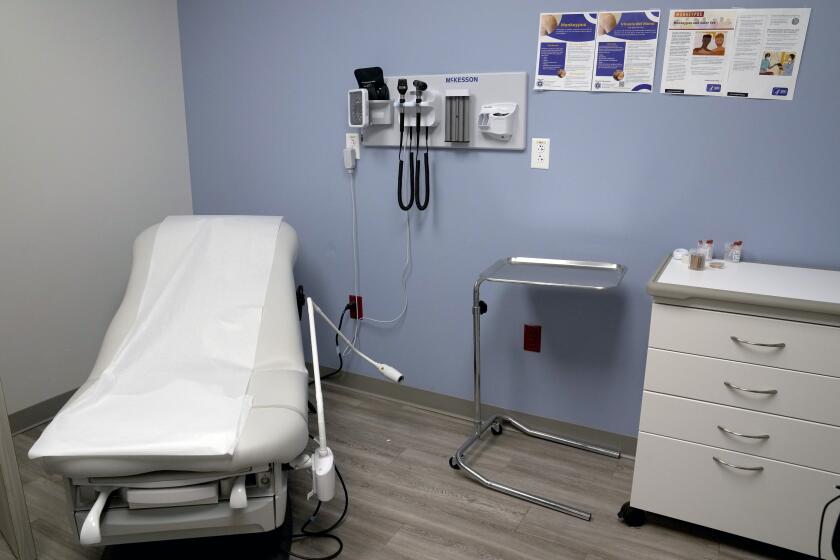Sailors Guarding Oil Live on ‘Target No. 1’
From a precarious catwalk 50 feet above the gulf, Navy Lt. Cmdr. Patrick Fulgham pointed to two large pipes protruding from the blue-green water below.
“This is target No. 1 for terrorists,” Fulgham said.
Ten months ago, four explosives-laden boats tried to blow up this oil facility and the nearby Khor al Amaya oil terminal, both about 20 miles offshore from the Iraqi port of Umm al Qasr. If the insurgents had succeeded, Iraq could have been dealt a serious economic blow and the oil spill might have rivaled the 1989 Exxon Valdez environmental disaster in Alaska, officials say.
Two U.S. sailors and a Coast Guardsman were killed when one of the approaching craft exploded as an American boat moved to intercept the insurgents.
The other bomb-laden boats exploded within 400 yards of the Al Basra terminal, where the two 48-inch pipes feed oil into tankers, after drawing fire from guards who worked for the Iraqi Oil Ministry.
Damage to the terminals was light. But the effect on U.S. military officials was profound. Today, the two rusting terminals, from which 90% of Iraq’s oil is exported, are possibly the most heavily guarded pieces of economic infrastructure owned by the Iraqi government.
“It was a wake-up call,” Rear Adm. Christopher Ames said of the April attack. “It affirmed what people had suspected: Those platforms are a lucrative target. Eliminating them would sever the lifeline of cash that Iraq needs to survive.”
The U.S.-led coalition has long had ships guarding the terminals, but the deployment of sailors to live aboard the terminals came only after the attack. The sailors were joined Feb. 12 by recently trained Iraqi infantry troops.
Fulgham is in charge of several dozen heavily armed sailors with Mobile Security Detachment 22 from Portsmouth, Va., who live aboard the Al Basra and Khor al Amaya terminals. The terminals are known as ABOT and KAAOT to acronym-happy U.S. officials.
“This is probably the most strategic asset in Iraq right now,” Fulgham said of Al Basra, which is twice as large as Khor al Amaya. “And we’re sitting on ground zero.”
The ships in the multinational armada under Ames’ command are equipped with the latest radar and antiaircraft guns in case insurgents attempt to attack the terminals with suicide planes. Navy SEALs, trained to thwart underwater sabotage, are deployed in the region.
There’s little margin of error for those protecting the terminals.
Even a partially successful attack could cripple the flow of cash to the Iraqi government and give insurgents a propaganda victory.
These are busy waters, where smuggling and piracy have long traditions. Hundreds of ships, large and small, ply the Persian Gulf each day. Sailors refer to the area around the terminals as Thunder Valley.
Navy and Coast Guard ships, as well as vessels from Britain and Singapore, maintain a nearly 3,300-yard “warning” zone around the terminals.
If unauthorized vessels come within 2,200 yards, sailors can open fire.
Every tanker that approaches the terminals is boarded by sailors to check for contraband. Smaller boats are boarded when sailors sense that something might be amiss.
“You’re on your toes all the time,” said Navy Capt. Michelle Howard, commander of maritime security operations in the northern gulf.
“You have to ask yourself, ‘Is this the guy? Is this the guy? Is this the guy?’ It’s a job that requires a belief that nobody can slip by.”
Navy officials would not say whether there have been unpublicized attacks on the two terminals, which can pump 1.7 million barrels a day.
“There’s never a day when something doesn’t happen,” said Ames, who uses the Navy amphibious assault ship Bonhomme Richard as his flagship. “Let’s leave it at that.”
By modern standards of technology, the oil terminals are elderly. Khor al Amaya is the older and most jerry-built. Sailors have put up a sign declaring it “Waterworld,” a reference to the 1995 Kevin Costner movie. “I’ve seen the movie,” Howard said. “ ‘Waterworld’ is nicer” than the terminal.
At Al Basra, four massive tankers can take on oil at the same time.
It requires about 72 hours to fill a tanker with a capacity of 2 million barrels.
U.S. personnel live at one end of the terminal, Iraqi soldiers and oil workers at the other. The catwalks that link the two ends are 1.2 miles long, with rails for safety in foul weather.
On both terminals, sailors enjoy Internet service, phone calls at 4 cents a minute, first-run movies and Armed Forces Network television.
The Super Bowl was broadcast live; food is brought out three times daily from nearby ships.
The gap of language and customs between the Americans and Iraqis is wide. But a pop culture artifact brought by the Americans seemed to work as an icebreaker: a life-size cardboard cutout of Elvis Presley in a shiny gold suit from his Las Vegas period.
“Yes, rock ‘n’ roll,” said one Iraqi.
Now, Elvis cutouts are on both terminals.
Still, there is an inevitable monotony to the routine of looking for threats on, under and over the water.
“It’s like ‘Groundhog Day,’ ” said Petty Officer 1st Class Stan Kubat, a reference to the 1993 Bill Murray movie in which the protagonist repeats the same day over and over. “But that’s good. Anything out of the ordinary, that’s bad.”
More to Read
Start your day right
Sign up for Essential California for news, features and recommendations from the L.A. Times and beyond in your inbox six days a week.
You may occasionally receive promotional content from the Los Angeles Times.





